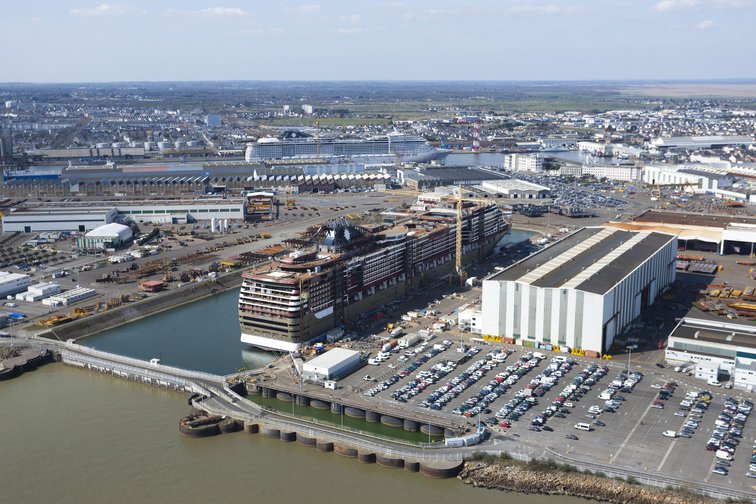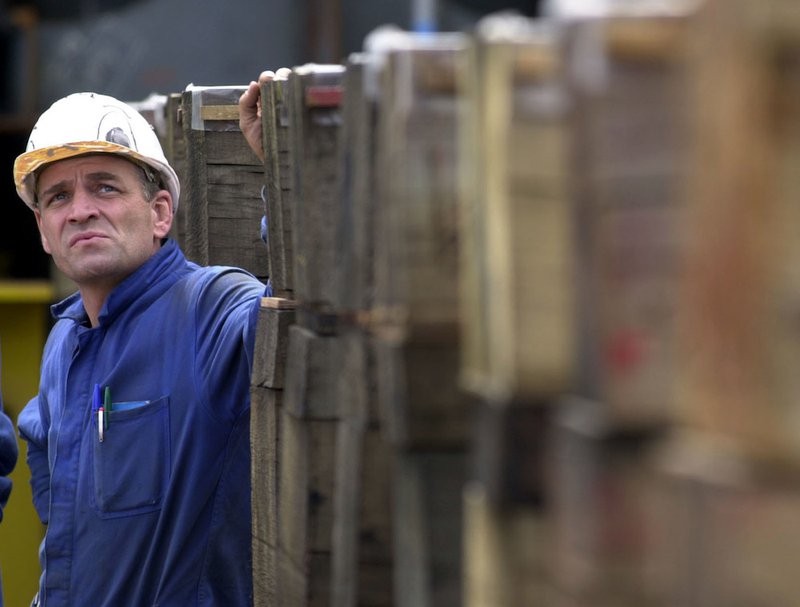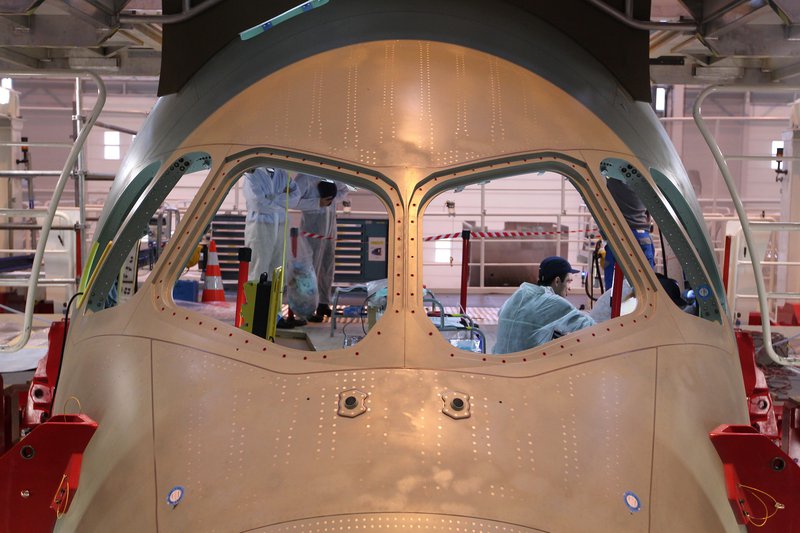
The unique experience of St Nazaire
France will be hit hard for its loyalty to the resource-guzzling monsters of modern industrialism.


The Airbus A380 is down the tubes. That horror of the skies, able to whisk 800 plus passengers in one fell swoop from Paris to the Pacific at the cost of 200 tons of aviation fuel a time, is being grounded in France on the off chance that someone will perform a miracle and come up with a positive use for it, other than scrap.
Bad news for the workers at Airbus in St Nazaire where much of the fuselage of any of its planes has been made before being delicately transported to Toulouse where the final aircraft are put together.
In the rather longer idle hours that may well be theirs over the coming years, they can wander down to the shipyards of their city and look at another carbuncle on the backside of the modern age, the vast cruise liners constructed in the shipyards of the Chantiers de l’Atlantique, state-owned, at least partly, since the Popular Front days of 1936.
You may have seen the aerial shots of empty cruise ships that Covid-19 has assembled in the Bahamas like a school of whales lazing in the sun on the surface of the ocean. How many people do you know keen to sign up for another world cruise? Not many more perhaps than the number of airlines that were ever ready to buy an A380 rowing in at less than twenty. If you might want to gloat at their current immobilisation go to Cruisemapper and try a name like Harmony of the Seas.
St Nazaire
There is not a great deal by way of distant history for tourists to see in St Nazaire. It was never much more than a blip in the expanse of marshlands at the mouth of the Loire until iron and steel shipbuilding arrived in the second half of the nineteenth century. What was then built up was largely wiped out when British and US bombers were sent to try to destroy the massive concrete pens protecting Nazi U-boats during Hitler’s attempt to cut Britain off from the world.
The post-war town is utilitarian and industrial. So instead tourists – all this, Covid-19 permitting – are invited to spend their time exploring the contradictions of modern industrial development. The experience is like no other.
For the war enthusiasts there are those pens. The bombs killed many a civilian but left the pens intact. A retired French navy submarine, the Espadon, has been docked in one to add to the authenticity. War is important to the French economy. Long the fifth largest exporter of weaponry, France has more recently consistently taken the third place among the world’s military merchants. Its producers are mollycoddled by repeated orders for the French military and by unending loan guarantees for risky sales to governments whose millions of poor citizens want nothing worse than a flight of Dassault Rafales on which to have their taxes wasted.
War is important to the French economy.

Thankfully, war on humans has not played a primary role in St Nazaire’s recent comparative prosperity. But war on the environment has.
After gawking at the waste of human effort involved and hesitating at panels hinting at some of the suffering of those forced by the Nazis to build the pens, there are three choices that help the spectator mull over the damage done to the planet by the production options France’s rulers have plumped for. They should be taken in historical order.
Tourists are not allowed on a ship under construction but they can visit the Chantiers de l’Atlantique and watch them being put together. As whenever steel is being bashed, riveted and welded, there is plenty of noise and the smells of hot oil, paints and chemicals. If you get there before the end of 2020 you may see the MSC Virtuosa before it is finished. To visit these centres of industrial might is an overwhelming, sobering experience. You see raw human power, no longer just squatting, chipping at a solitary flint, sharpening an antler, scraping a lone cow’s hide or pounding some corn into flour, but human power at the apex of a worldwide system of activity and exchange.
What else might these yards and workshops have constructed? Or is the form of the productive enterprise and the market it serves, such that it is only harmful things their workers can offer to humanity?
The liners themselves have become a real example of that pile ‘em high, sell ‘em cheap slogan. Marseilles is a huge city and its port is the biggest in France but the cruise liners sitting there, tied up at the dock make all else feel small and insignificant. More daunting even that the layers of shipping containers ranked one above the other on the super-carriers from China, are the serried rows of cabins reaching ten storeys high above the line of lifeboats at the ships’ gunwales, dwarfing the cranes, the churches and the warehouses of the port’s traditional sky-line.
On some summer days, to walk along that sea front when there was just one cruise liner awaiting its next round of passengers, its motors turning over to keep the whole floating city in power, was to have one’s lungs filled from the exhaust of engines running on that most noxious version of hydrocarbon fuel, heavy marine oil.
Since the Costa Concordia crashed into the Italian coast in 2012 the things have got ever larger, with those coming out of St Nazaire leading the way. The words “gigantesque” and “gigantisme” are everywhere in the handouts from the town’s tourist office that organises the tours to all these venues. When the epidemic struck, the Chantiers de l’Atlantique were planning 20 more cruise liner launches between now and 2030. No one can forecast what is going to happen now.
The Airbus factory

Then there is that Airbus factory. Like the shipyard, you have to book in advance to get the best of the guided tours, but here you will also be rewarded by a twenty-first century work experience: it’s quieter, cleaner, rather clinical in its feel. Even in the most modern shipyard, there are still tasks reminiscent of someone adzing out the heart of a large tree trunk to form a stone-age canoe: the use of brute force against natural materials, perhaps? Not so at Airbus. This is science and technology at their most advanced.
An end to the production of the A380 had been called before Covid-19 halted France. Back on 14 February, Airbus announced that no more would be made beyond the handful due for delivery in 2021. In any case, despite the talk at one stage of making a couple of thousand of the things, the only sales of real importance had been to the Emirates airline. It took nearly half the output of A380s with a fleet now running at 115.
The fall out from the crisis of the modern mass passenger trade induced by the virus is going to be big and will hit many communities hard. But the problems faced by these planes are only a metaphor for the fundamental issue of a vast industry built upon an unsustainable or highly risky gigantism where larger, faster, further are the mantras that dominate.
In France, the whole of Airbus is now at risk and, even before the epidemic, the Chantiers de l’Atlantique were slated to survive only if the Italian state’s equivalent, Fincantieri, went ahead with a takeover deal. The European Union has been holding things up on grounds of “competition”. Which has not stopped the boss of Italian firm, Alberto Maestrini, going a stage further and saying that the new mastodon should include the submarine building yards of the German Thyssenkrupp.
This has been big industry with “charismatic leaders”, that is men who so believed in themselves that they need listen to no one else; oodles of money, rarely theirs; state and local authorities prepared to build roads, reshape bridges, construct ports, and transform landscapes. All made it possible for these giant chunks of private capital to realise their engineering dreams. Not a solely French phenomenon, granted, but one that guaranteed the success of the aircraft and the cruise liner industries in the Hexagon up to now.
The parallel we are more aware of is the ruthless policy pursued by Michael O’Leary of Ryan Air whereby local authorities across Europe have been cajoled into paying an airline, whose great speciality is to convert its passengers into sardines, to use their local airport for its flights.
Both the cruise ship and the large passenger jet have soaked up public money, usually indirectly (for instance, if you keep Air France afloat financially then the airline can continue to buy Airbus jets) but often also directly, as now during the Covid crisis. The whole lubricated by constant, massive doses of corruption and what the French call pantoufle, or slippering, where senior figures glide discretely between top state and private sector jobs. If ever you get to see a photo or a film of the French Covid emergency team meeting with Macron in the Elysée’s salle de crise, look for the one sitting beside the President: Alexis Kohler.

In January, MSC, the Swiss-Italian giant of the cruise and shipping trade, popped in an order for two more ships from Chantiers de l’Atlantique. One of them will be the biggest the yards have ever constructed. While Kohler was working at the French Finance Ministry a decade ago, he was, among other things, the state’s figure on the board of the Chantiers with one third of the shares as his stake on the table. A bit later, he was Macron’s “Directeur de cabinet” when the President was just Economics Minister. When Macron sloped off to organise his election campaign, Kohler was the financial director of MSC. His mother’s cousin was the partner of the founder of MSC. When Macron got the Presidency, Kohler was made Secretary-General of the Elysée.
The A380 cost at least 12 billion Euros to develop. Imagine what you could do with a sum that large, with the inventive capacity of the teams and technology involved, with the resources before you in these Airbus assembly halls.
Follow the techie media and the opportunities created by new science and technology are mind-boggling. But that media is also full of the terrifying bombast of modern day equivalents of Isambard Kingdom Brunel. His Great Eastern was the largest ship ever built when it launched in the Thames in 1858 and remained so for forty years. Designed to take 4,000 passengers to Australia, the ship was, like the A380, a complete commercial failure. It ended up laying telephone cables across the Atlantic (some to St Nazaire) before becoming a floating music hall on the Mersey. At least there was just one Great Eastern, some of his modern equivalents dream of inundating our cities and countryside with fleets of aerial taxis and delivery drones.
At least there was just one Great Eastern, some of his modern equivalents dream of inundating our cities and countryside with fleets of aerial taxis and delivery drones.
Whenever there is a poll to discover the most popular historic Briton, Isambard, whose father was French, comes in the top half dozen. One hopes that at Air France there is no plan to convert its redundant super-carriers into nightclubs in the stratosphere in the hope that its boss may gain entry to the Légion d’honneur.
Dreaming and life after COVID
The fourth and final destination in St Nazaire should be the EOL Centre éolien showing the green energy projects that France has been obstinately behind the game in installing. The country’s official focus has been on the new nuclear power station at Flamanville on the Normandy coast, started in 2007 and still far from completed, despite eating up a budget greater than that spent on green energy. During the lockdown it was announced that its reactors would now not start working until 2024. The St Nazaire displays on how we might create a different future, one dominated by green choices, hopefully inspire visitors who stay the pace, to rethink what they have seen at the pens, the yards and the Airbus assembly halls.
At the Centre Eolien you can also see some of the stages of manufacture of the generators for the wind farm off the coast that should open in 2022 with 80 of them in a first array.
But take care. Being a sardine in one of O’Leary’s jets is an option many of us have chosen on our way to some sun or a New Year party in Prague when the alternative has been a ticket at four times the price. Freedom is not just a matter of being allowed to have the dreams you want, it also means having the capacity to turn them into reality. For those stuffed into concrete tower blocks in Paris’ 13th arrondissement, in Saint Denis, or the northern swathes of social housing in Marseilles, escaping, even if only briefly, has only been possible thanks to a cut-price airline or saving until retirement for that Caribbean cruise.
The romance of the first paid holidays in France under the Popular Front of the 1930s – those photographs of a whole family cycling off on their first ever such indulgence, recycled in exhibition after exhibition, coffee table book after coffee table book – has long been replaced by a leisure time in which most are consuming more energy and natural resources than in their working lives. And, remember, the Gilets jaunes explosion was triggered when Macron cynically sought to impose the costs of going green on those least able to pay: those for whom his drastic hike in diesel duties meant they could no longer afford to go to work.
One further exhibition in St Nazaire is a display of the luxury aboard some its shipyard’s great liners of the past. Visitors, for instance, are invited to wallow in envy over the way rich passengers were pampered on the Normandie, launched in 1935, and the fastest trans-Atlantic liner in its day with most passengers going first class.
It is a dangerous place. It stokes those dreams, that jealousy over the way some have, and are still able to indulge, as if to suggest that partaking in the luxury of a world cruise on the Harmony of the Seas is something every human should want to do, as if the way forward for all on earth is the SpaceX project by Elon Musk, recently successful in taking its first astronaut crew to the International Space Station and now ready to be used by ultra-wealthy space tourists.
Envy of those running the system that is rushing the world to a black hole of environmental disaster is no proper basis for policy.
Envy of those running the system that is rushing the world to a black hole of environmental disaster is no proper basis for policy. But to break such a link we need not abstinence, but to enable the human capacity to dream and to create – to do so positively, recognising the necessity of what has to be done to make sustainable a good life for all.
Certainly not the solution offered by Macron to the immediate problems at St Nazaire. He sent his Defence minister Florence Parly there to promise that sometime in the future, in the 2030s to be imprecise, there would be work. When the aircraft carrier Charles de Gaulle, renowned across the planet for having been immobilised by Covid-19, runs out of steam, the replacement will be built in the shipyard that has turned out the biggest cruise liners in the world. It is a frightening signal of how the French President sees the “after Covid”.
Parly’s set date for its commissioning is 2038. A child born now will be an adult then. What an affront to the hopes of millions that those in charge of one of the finest industrial and technological resources in the world, should think of nothing better than yet another killing machine to keep its productive wheels turning while that baby grows to maturity.
Read more
Get our weekly email




Comments
We encourage anyone to comment, please consult the oD commenting guidelines if you have any questions.